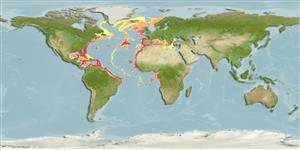Issue
This species is often confused with Nezumia sclerorhynchus (Valenciennes, 1838).
Environment: milieu / climate zone / depth range / distribution range
Sinh thái học
Biển Sống nổi và đáy; không di cư; Mức độ sâu 200 - 2320 m (Ref. 3587), usually 200 - 1000 m (Ref. 2683). Deep-water; 70°N - 12°S, 98°W - 30°E (Ref. 1371)
Atlantic Ocean: Eastern Atlantic: Faroe Bank to northern Angola and the Mediterranean Sea. Western Atlantic: Davis Straits to northern Brazil.
Length at first maturity / Bộ gần gũi / Khối lượng (Trọng lượng) / Age
Maturity: Lm 4.5, range 4 - ? cm
Max length : 36.0 cm TL con đực/không giới tính; (Ref. 3587); common length : 25.0 cm TL con đực/không giới tính; (Ref. 2683); Tuổi cực đại được báo cáo: 9 các năm (Ref. 58045)
Các tia vây lưng cứng (tổng cộng) : 2; Tia cứng vây hậu môn: 0. Head short, completely scaled except for naked strip on the ventral surface of the snout; Eyes relatively large, 29 to 42% of head length; snout short, pointed; chin barbel very short. Body scales with lanceolate to shield-shaped spinules. Overall color is bluish to violet, head somewhat tawny to swarthy; ventral portions silvery when fresh; pelvic fins black except outermost ray which is pale to white; oral cavity grayish; branchial cavity mostly black.
Feeds on benthic as well as pelagic animals like mysids, amphipods, small shrimps, copepods, isopods, ostracods and polychaete worms (Ref. 6187).
Life cycle and mating behavior
Chín muồi sinh dục | Sự tái sinh sản | Đẻ trứng | Các trứng | Sự sinh sản | Ấu trùng
Cohen, D.M., T. Inada, T. Iwamoto and N. Scialabba, 1990. FAO species catalogue. Vol. 10. Gadiform fishes of the world (Order Gadiformes). An annotated and illustrated catalogue of cods, hakes, grenadiers and other gadiform fishes known to date. FAO Fish. Synop. 125(10). Rome: FAO. 442 p. (Ref. 1371)
IUCN Red List Status (Ref. 130435: Version 2024-1)
Threat to humans
Harmless
Human uses
Các nghề cá: buôn bán nhỏ
Các công cụ
Special reports
Download XML
Các nguồn internet
Estimates based on models
Preferred temperature (Ref.
123201): 4.7 - 15.7, mean 9.3 °C (based on 786 cells).
Phylogenetic diversity index (Ref.
82804): PD
50 = 0.5000 [Uniqueness, from 0.5 = low to 2.0 = high].
Bayesian length-weight: a=0.00186 (0.00113 - 0.00306), b=3.12 (2.97 - 3.27), in cm total length, based on LWR estimates for this species & (Sub)family-body (Ref.
93245).
Mức dinh dưỡng (Ref.
69278): 3.3 ±0.1 se; based on diet studies.
Thích nghi nhanh (Ref.
120179): thấp, thời gian nhân đôi của chủng quần tối thiểu là 4.5 - 14 năm (Preliminary K or Fecundity.).
Fishing Vulnerability (Ref.
59153): Low to moderate vulnerability (26 of 100).
Nutrients (Ref.
124155): Calcium = 21.3 [10.3, 49.2] mg/100g; Iron = 0.34 [0.16, 0.70] mg/100g; Protein = 15.9 [14.1, 17.5] %; Omega3 = 0.248 [0.102, 0.566] g/100g; Selenium = 26.9 [9.5, 68.2] μg/100g; VitaminA = 16.6 [3.0, 84.1] μg/100g; Zinc = 0.505 [0.312, 0.823] mg/100g (wet weight);
